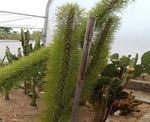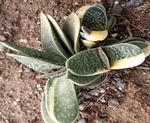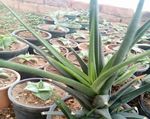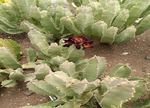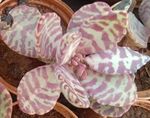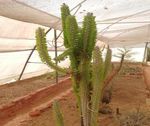Documentation Of Succulents From Agriculture Farm Of Dehgam Area, Gujarat
←
→
Page content transcription
If your browser does not render page correctly, please read the page content below
International Journal of Research in Advent Technology, Vol.7, No.4, April 2019
E-ISSN: 2321-9637
Available online at www.ijrat.org
Documentation Of Succulents From Agriculture Farm
Of Dehgam Area, Gujarat
Mrunali Kolhe1, Shirin Qureshi2, Archana Mankad3, Hitesh Solanki4
1
M.Sc. student, 2Research Scholar, 3,4Professor
1,2,3,4
Department of Botany, Bioinformatics, Climate Change Impacts Management, Gujarat University,
Ahmedabad-9.
Email id: husolanki@yahoo.com
Abstract:Succulents are plants that consume some portions that are more than generally condensed and fleshy,
usuallyretain water in arid climates or soil. The word “Succulent” comes from the Latin word „Sucus‟ meaning
juice or sap. Most of Succulents are native to dry, arid regions such as a desert.Succulents are very interesting
group of plants that are found in its natural environment. Mostly in South Africa,succulents are also called
xerophytes but not all are xerophytes. The Succulent leaf is highly specialized when the stem is inattentive,
leaves grown are hidden in the soil for reducing water loss. Stem succulents belongto cactus family. Succulents
stem have leaves which are reduced in size. Root Succulents are associated with annual stems that desiccate
duringdry season. We visited Poonam agriculture farm, Ahmedabad, Gujarat in India in year 2018-2019 for 3
months. We saw 296 species of succulents in the field and out of them, we studied 13 genera having above
characters which are: Agave, Aloe, Alludia, Crassula, Caralluma, Dyckia, Didierea, Euphorbia, Gasteria,
Haworthia, Kalanchoe, Sansevieria, Senecio.From the above study, we conclude that this farm is one of the
diverse regions for succulents and cacti found in Gujarat.
Keywords: Succulent, Xerophytes, Dry, Gujarat.
1. INTRODUCTION organ allows the plant to survive for long
“Succulents are plants that consume some time. This organ contains water and
portions that are more than generally condensed nutrients.
and fleshy, usually to retain water in arid climates 4) Bulbous: Bulbous is a storage organ. It is
or soil”. The word “Succulent” comes from the globular with fleshy leaves that store food
Latin word Sucus, meaning juice or sap. Most of &water. It is globular in shape. It is
succulents are native to dry, arid regionssuch as a difficult to grow during summer because
desert. vines dry up completely, plant gets spots
Succulents are very interesting group of plants that during spring (Dortort,2011).
are found in its natural environment, mostly in
South Africa. Succulents are also called xerophytes 3. HABITAT OF SUCCULENTS:
but not all are xerophytes. The Succulent leaves are The habitat of Succulents are diverse, overall the
highly specialized when the stem is inattentive five contains that have concentrations between
leaves grown hidden in the soil for reducing water 30‟N and 30‟S latitudes among all the largest
loss. Stem succulents belong to cactus family. inSouth Africa and Sub-Tropical America. South
Succulent stem has leaves which are reduced in Africa is said as the natural home for the widest
size. Root Succulent is associated with annual range of other Succulents. Human interventions
stems that desiccate during the dry season have made it difficult to decide the exact native
(Anderson, 2006) habitat of a species, even less genus (Bewli,2016).
2. THE SUCCULENTSCLASSIFIED ARE 4. DISTRIBUTION:
DIVIDED INTO FOUR MAIN PARTS OF South Africa and subtropical North and South
PLANT. America would score highest for numbers of
1) Leaf Succulents: Leaf succulent plants speciesas well as for density populations. America
are that store water inside their leaves so is the home of the cactaceae family and the Century
that they become fleshy. plants (Agave), Various Crassulaceae
2) Stem Succulents: Stem Succulents plants (Echeverioideae), somePortulacaceae.
have thick fleshy stem that store water in Euphorbiaceae and others. South Africa is the
their tissue. The reduction of leaves is not home of the widest range of all Succulents.
a prerequisite for stem succulents as many Crassulaceae is distributed in Tillaea
stem. Succulents maintain large leaves (Anderson,2006).
during the growing season.
3) Caudiciformis:Caudiciformis are plants 5. PROPAGATION:
that evolve water storage organ which is The main two techniques are Succulents for
either underground or overground. This propagation.
71International Journal of Research in Advent Technology, Vol.7, No.4, April 2019
E-ISSN: 2321-9637
Available online at www.ijrat.org
1) Seed Propagation: growth especially when Succulents grow in
Not only for succulents but for other greenhouse.
plants, one cannot get a real pleasure in Soil: Soil is important component for the Succulent
growing plants or succulents without the growth. Succulent need well drained dry soil. Soil
use of seeds. is very important because they provide nutrients.
Soil made by mixture of sand, soil, fertilizer &
2) Vegetative Propagation. peat. Soil pH is to be maintained. Succulent growth
Almost all the succulents lend is well seen in slightly acidic soil.
themselves vegetative multiplication by Planting: Planting can occurin almost any pot,if
division, offsets, suckers, cuttings & allowed enough room to cater for the roots of the
grafting. plants and sufficient repotting is only ever required
when the roots start to burst out from the base of
5.1 Cutting: the pot or become obvious on the surface of the soil
Some of the matured twigs are to be separated by (Dortort,2011).
horizontal cut and dried, for the less of moisture to Experimental site:We worked on Succulents in
some extent, sometimes a root promoter is used for 2018-2019 for 3 months. We visited Poonam
advantage. The time of preparing cutting depends Agriculture Farm, Ahmedabad, Gujarat in India.
on the type of plant. The total area of the farm is 15 acres. The farm
5.2 Cutting Propagation: environment was dry.There were three greenhouses
While seed propagation is relatively easy, most present in the farm. In the first greenhouse, the
gardeners have better success with growing from covered area was 20 to 30 square meter and other
cuttings. two greenhouses were covered with small area in
5.3 Leaf Cutting: the farm. Small two greenhouses in the farm were
Propagation by leaf cutting is also useful method totally covered with the white 50% shaded film that
practically for Succulents other than cacti. Some of is the UV stabilizedpolythene film. Mostly
the Succulents are propagated from leaf cuttings Succulents- all the species were in small two
are Kalanchoe, Sedum, Gasteria. greenhouses. In these greenhouses, there are
5.4 Grafting: different beds for plantation of Succulents.
It is another method of propagation that involves
the union of plant part to be multiplied that is 7. DOCUMENTATION OF SUCCULENTS
termed as scion with another rooted part called In the greenhouse mostly around 296 species of
stock (Dortrot,2011). Succulents were observed. Cactiiwere also present
in the greenhouses but as compared to
6. CULTIVATION OF SUCCULENTS: cactus,Succulents were less. Out of 296,we
Location:The combination of water, soil, and light studied13 genera of succulents. The documentation
should be according to the specific area where the of Succulents was done by describing the following
plant is grown. The basic cultural recommendation characteristics in detail as: Habitat, Plant body,
given from the environment of Ahmedabad, Flowers, and Propagation.
Gujarat in India, is that it is an area of high Agave (Linnaeus): Agave is native to Mexico in
temperature infrequent moderate winter and North America. It has approximately 200 species in
summer days with temperature above 42°C-45°C. the family Asparagaceae. It is a rosette form
Water: Watering succulent plants is one of the ofsucculent. Leaves are leathery and 2.5 meter in
riskiest parts of growing them. Succulents are length, depend on the species. Mostly, species have
geniuses of nature that store extra water in their their own terminal spine. The flowers are clusters
leaves, stem, or root. Because they have the are borne at the top of a very robust flowering
reputation for growing in arid situations, many stem.
people fail to understand that when we transport Aloe (Linnaeus): The Aloe grows wild in tropical
them into our home and garden atmospheres, they and sub-tropical lands. They need dry atmosphere.
do need to be watered regularly. The Succulent leaf of the Aloe is an adaptation to
Climate:Succulents need full sun position and they the dry condition. The plant is stem-less or very
grow in temperature like hot climate, others are short-stemmed with an average about 20 leaves in a
very sensitive to cold in cool season.For the straight, dense rosette. The leaves can grow up to
Succulents, winter is a dormant season and summer 40-50 cm long and 6-7 cm wide. The plants will
is growing season. bloomafter at least 4 years of age.
Temperature: Temperature is an important Alludia: This genus forms part of the thorn-shrub
component for the succulents. Succulents need forest in Madagascar. Most species of Alludia have
colder temperatures at night below 30°C and in the a juvenile growth form of a branched shrub a few
day, they need full sunny position, temperature meters, eventually forming a single-trunked tree,
between 40°C to 45°C.Difference between night branching well above the ground. They will not
and day temperature is most important for the plant tolerate prolonged frost but make excellent full-sun
72International Journal of Research in Advent Technology, Vol.7, No.4, April 2019
E-ISSN: 2321-9637
Available online at www.ijrat.org
patio plants, until they grow too large to be moved found from the central to the Southern ridge and
indoors. Most are easily propagated from cuttings; hills of the Drakensberg. Kalanchoe are grown up
they are not often grown from seed as it is rarely to 12‟ inch in height they prefer full sunlight for the
available (Anderson, 2006; Dortort,2011). growth (Anderson,2006; Dortort,2011).
Crassula(Linnaeus): This genus has 200 species of Sansevieria: It is perennial, rhizomatous herb
succulent plant with varying ssize. Crassulas are without stem. Leaves 13-30 in a rosette blade
distributed throughout the world but the majority Hardly linear, erect to slightly spreading, margin
are from South Africa. It is hardy plant. They are red with colourless outer point. Native to Africa
small perennial plant and up to 60 mm height. and Asia (Anderson,2006 ; Dortort,2011).
Flower is cup-shaped, and the petals are 2 and 2.5 Senecio: This genus has thousands of small, annual
mm long (Anderson,2006; Dortort,2011). and perennial shrubs. It has thick leaves thick stem
Caralluma (Robert Brown): They are native to and tuberous. It is native to Africa, Madagascar,
India. The Caralluma genus is such genus of edible Mexico as well as the Canary Island and the East
Cacti, that includes some species, grows across Indies. The plant body looks like green pencil
India. The stem is up to 15 cm in height. It is rising from the ground and the main stem has few
straight branched herb. It has been eaten branches. Flowers are five petals and 2 to 4 mm
asvegetable in rural India. Flowers are five-pointed long (Anderson,2006; Dortort,2011).
thick stars coloured black, purple or red produced
in late summer or autumn (Anderson,2006; 8. CONCLUSION:
Dortort,2011). There are total species of 11,000 to 11,045
Dyckia: Dyckia is very attractive plant up to 20 cm approximately and 550 genera of succulents in the
tall, with rosettes up to 30 cm wide. The leaves are world. Out of these we saw 296 species of
short, glossy, deep green and purple in full sun and Succulents in the fieldand studied these 13 genera:
are covered in silvery scales. Most Dyckia species Agave, Aloe, Alludia, Crassula, Caralluma,
have leaves armed with sharp spikes. In spring to Didierea, Euphorbia, Gasteria, Haworthia,
summer, they can appear attractive up to 90 cm tall Kalanchoe, Sansevieria, Senecio. Out of these, 3
stalks of yellow-orange flowers (Anderson,2006; rare species were observed: Didierea
Dortort,2011). madagascariensis, Alludia procera & Haworthia
Didierea: The member of the Didiereaceae, found cooperi var. truncata. From the above study, we
almost nowhere but in Madagascar, may be the conclude that this farm is one of the diverse regions
most distinctive of that islands succulents. The for Cacti and Succulents found in Gujarat. Due to
eponymous genus Didierea consists of two species industrialization, there is a loss of succulents;
D. madagascariensis and D. trollii. Seedling of hence, it is very important to conserve them.
Didierea madagascariensis resemble miniature
unbranched mature plants and grow upright, ACKNOWLEDGMENTS
straight as a ruler (Anderson,2006; Dortort,2011). We would like to thankDr. Vashram P. Boda for
Euphorbia: Euphorbia genus of Euphorbiaceae providing us guidance and research field. We
family. Itcontains minimum 2100 species and is would also like to thank Department of Botany for
one of the most diverse groups of flowering plants. providing us the facilities for research work.
The origin of Euphorbia is in Southern and Eastern
Africa and Madagascar but they also found in REFERENCES:
Tropical Asia and America. The leaves are simple, [1] Anderson R.“The Complete Guide to
opposite and sessile. The stem is fleshy, terete, growing Cacti & Succulents: A
branched, reddish and laticiferous (Anderson,2006; comprehensive guide to identification,
Dortort,2011). care and cultivation”. sAnness publishing
Gasteria: Gasterias are thick, hard succulent Ltd, pages 8-17.2006.
“tongue-shaped” leaves. It is long leaved, drooping, [2] Bewli C. S.“Cacti Culture Prickles of
succulent shrub with long, fleshy stems. Plants are Pride”. Fingerprint Life, pages 13-24, 37-
branched from the base with stems becoming 66, 2016.
overhanging and up to 1 m long (Anderson,2006 ; [3] Dortort F. “Guide to Succulent plants of
Dortort,2011). the World: A comprehensive Reference to
Haworthia:The largest genus of dwarf succulents‟ more than 2000 Species.” The Timber
plant within the family Xanthorrhoeaceae. Origin press, pages 15-23, 28-31, 39-44, 66-67,
of Haworthias from South Africa and South West 101-102, 212, 247, 254-259, 270-271,
Africa. The genus Haworthia comes from the 282, 296-303. 2011.
botanist Adrian Haredy Haworth. The flowers are
white and small with single spike (Anderson,2006; WEBLINKS:
Dortort,2011). [1] http://www.llifle.com/
Kalanchoe:It is native to Africa, Madagascar and [2] https://worldofsucculents.com/
Malaysia. It is a very well-known genus. It is
73International Journal of Research in Advent Technology, Vol.7, No.4, April 2019
E-ISSN: 2321-9637
Available online at www.ijrat.org
[3] https://www.sciencedirect.com/science/art [5] https://www.ambius.com/indoor-
icle/pii/S0960982217302907 plants/the-ultimate-guide-to-succulents/
[4] http://www.newworldencyclopedia.org/ent
ry/Ag ave
Agave desmintiana var. Joe Hoak Alludia procera Euphorbia lactea variegata
Aloe aristata Didierea madagascariensis Gasteria lilipuntana variegata
Crassula ovata var. lemon & lime Caralluma speciosa Haworthia attenuata var. radula
Dyckia brevifolia Sansevieria sp. & Senecio radicans Kalanchoe humilis
Photoplates: Documentation of 13 Genera of Succulents
74You can also read




